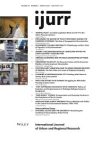On 9 February 2025, the streets of Pune resonated with the slogans ‘Majhi Nadi, Majhi Jababdari’ [1] (My River, My Responsibility), ‘Nadi Vachva, Jhade Vachva’ (Save Rivers, Save Trees). Thousands of citizens participated in the Chipko March on a Sunday afternoon to protest against the city administration. Under the initiatives of the local organizations, Pune River Revival and Jeevitnadi-The Living River Foundation, the march was planned when the local government started mapping and numbering thousands of native trees, which were to be ultimately felled, over a 9 km stretch along the river banks of the city. The name ‘Chipko’ was coined to commemorate the popular environmental movement in Northern India from the 1970s, which aimed at the conservation of forests. The word ‘Chipko’ referred to the hugging of trees to prevent them from getting chopped, and the movement from five decades ago had witnessed large-scale participation of grassroots-level organizations, rural women, activists, and other citizens. The Chipko March in Pune was a tribute to this successful movement from the past and a symbolic reference to the need for urban residents to embrace trees to feel reconnected with nature.
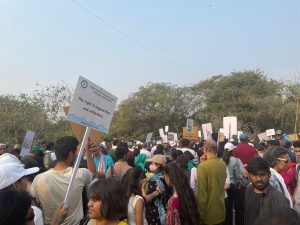
Chipko March, Source: Mathilda Kratz, 9th February 2025
This march becomes especially significant in the context of the rivers in Pune losing their vitality and the ecosystems around them gradually disappearing. Pune City, located on the western side of the Deccan Plateau and the leeward side of the Sahyadri Hills in the state of Maharashtra in Western India, has various geographical advantages. The city has been home to various tributaries, with the Mula and Mutha being the major rivers traversing it. Pune experiences heavy monsoons due to this terrain. However, owing to the deteriorating climatic conditions and urban environment, the rainfall is drastic every year and is predicted to exponentially increase over the subsequent decades (The Energy and Resource Institute, 2021). Besides heavy rainfall, the city has been experiencing severe flooding of the rivers in the recent past, particularly in 2019 and 2024. This phenomenon can be attributed to various factors such as the concretization plans that breach flood lines, deforestation on the riverfront and metro rail transit development banks, draining of industrial effluents into the water, inefficient stormwater drainage systems, and solid waste disposal. While Pune has been identified as one of the most liveable cities in India with its green environment and stellar solid waste management program, along with other factors (Ease of Living Index, Ministry of Housing and Urban Affairs, 2018; Quality of Living City Ranking, Mercer, 2023), the ground reality bears testimony to a different narrative.
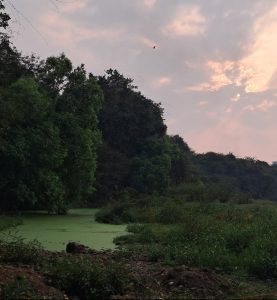
Ram-Mula River Confluence, Source: Author, 9th February 2025.
Riverfront development projects are not novel concepts in Indian cities, where placemaking has been one of the governing ideas. Considered a success story by the Indian state, the Sabarmati Riverfront Development (SRFD) Project can act as a point of reference, which bore the promise of ‘reconnecting’ Ahmedabad [2] with its river. However, as legal scholars Joshi and Maheshwari (2016) point out, the SRFD project met with severe criticisms from both citizens and civil society groups, as well as planners and architects, due to the large eviction drives that prompted the relocation of marginalized communities residing near the river banks. This resulted in unsustainable rehabilitation plans, which excluded economically and socially deprived communities from the visions of urban development. Similarly, the Yamuna Riverfront Development (YRFD) Project undertaken by the Delhi Development Authority, aiming for river rejuvenation, has also been under various forms of scrutiny. As Naruka (2022) argues, the YRFD not only promises a future that fails to accommodate the interests of different stakeholders but also reveals the local state’s ambitions of ‘commodifying’ riverfronts. With such examples witnessed in other urban centers, the municipal corporation’s intentions in Pune are being met with skepticism, especially with a hefty budget of around 4700 crores INR/ 54 million USD (approximately) assigned to the project. Activists have refuted the clearance given to the riverfront development project by the State Environment Impact Assessment Authority. In this regard, petitions have been filed with the National Green Tribunal to seek clarification as to whether the project will diminish flood risks in Pune or augment them. In this context, the Chipko March became necessary to display citizens’ initiatives and interest in creating a sustainable urban future for Pune. The march was also an urgent cry for help in the context of hundreds of trees disappearing in the middle of January 2025, due to the active deforestation efforts of the city administration.
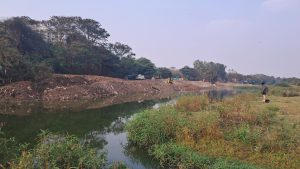
Riverfront development project in progress. Source: author, 9th February 2025.
City-level organizations, Pune River Revival and Jeevitnadi- Living River Foundation, which spearheaded the march, had been enthusiastically undertaking diverse initiatives to rejuvenate the rivers with the help of volunteers. From cleaning the river banks to planting new saplings, from arranging different cultural events, tree and river walks, to tree mapping, these organizations have been focussed on spreading awareness regarding the ‘dying rivers’ of Pune and inviting citizens to be more connected and involved in the restoration process. The Chipko March proved to be an important event where people were found to be willingly disposing the garb of apathy towards urban environmental issues. Little school children and the elderly, belonging to different socio-economic groups, raised their voices in unison to protect Pune’s trees and rivers. After a 1.2 kilometre march, the citizens gathered at the confluence of the Ram and Mula Rivers to witness the condition of the rivers and the status of the riverfront development project. Postcards were distributed among the participants for those who desired to write to the Prime Minister of India, with a plea to stall the process and save the trees and rivers in Pune. The march received impetus from environmental activist Sonam Wangchuk [3] and local film actor Sayaji Shinde. However, despite the presence of renowned personalities, it remained a people’s demonstration.
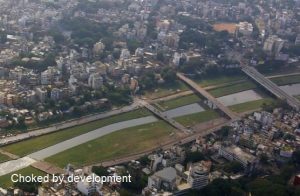
Pune Municipal Corporation’s claim that the river is ‘Choked by Development’. Source: https://www.pmc.gov.in/en/riverfront
With urban futures being in jeopardy due to the threats of climate change, the vision of a green city should be crucial. Instead, regressive developmental practices are being rapidly implemented in different urban centers of India. Ironically, the Pune Municipal Corporation’s website on the riverfront project claims that the river is ‘choked by development’; while at the same time venturing into concretization plans by felling trees. The contradictory messages conveyed by the local state show the gaps in imagining a sustainable urban future. Indian riverfront development projects often take inspiration from global cities. For instance, the Thames and Senne Riverfronts in London and Paris influence the Yamuna Riverfront Development project. In this process, the planners and officials often fail to incorporate the visions of the local residents. Urban development has been consistently equated with infrastructure building, without accounting for the environmental costs. With several global cities turning into heat islands, the necessity to create more green spaces cannot be undermined. Moreover, when city administrations overlook these concerns, events like Chipko March become increasingly important.
[1] In the local language, Marathi.
[2] The capital of Gujarat, a state located in Western India.
[3] Wangchuk is well-known innovator who has consistently worked on environmental issues, especially in Ladakh, located in the Himalayan region of North India.
Debapriya Ganguly is an Assistant Professor at the Department of Sociology, Savitribai Phule Pune University. Her research interests include Urban Studies, Social Theory, Sociology of Disasters and Popular Culture. She has recently published on digital populism, pedagogical changes in higher education, and high streets in urban India.
Related IJURR articles
Naruka, Y. (2022). Future of a Dying River: Bureaucratic Practices and Negotiated Plans of the Yamuna Riverfront. International Journal of Urban and Regional Research, 46(5), 874-884.
Millington, N. (2018). Linear Parks and the Political Ecologies of Permeability: Environmental displacement in São Paulo, Brazil. International Journal of Urban and Regional Research, 42(5), 864-881.
